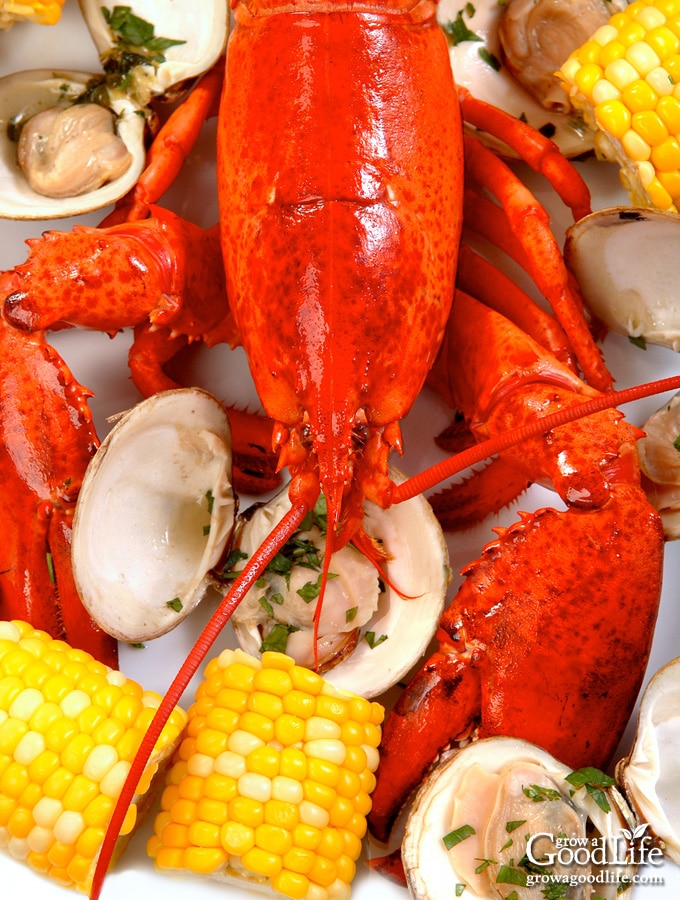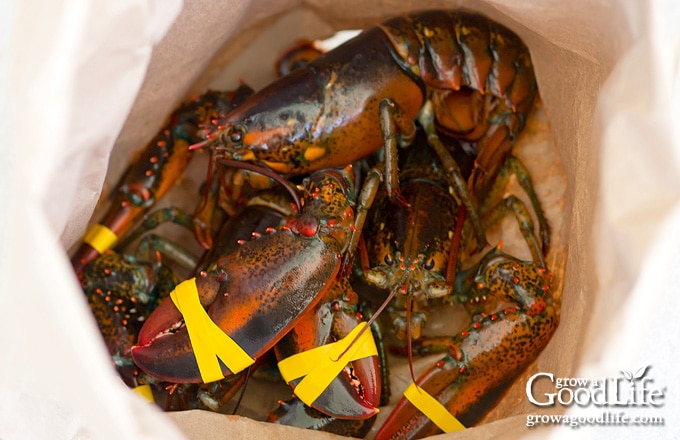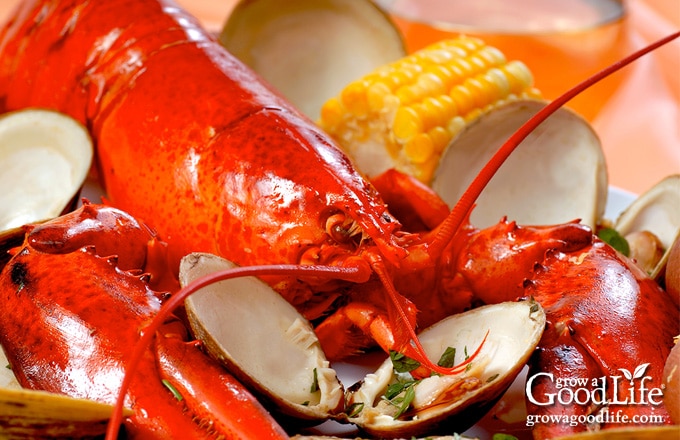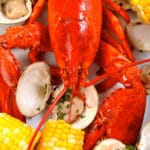Classic New England Clambake
This post may contain affiliate links, which means that I may receive a commission if you make a purchase using these links. As an Amazon Associate I earn from qualifying purchases.
If there is one thing that really screams summer in New England, it’s a classic New England clambake with friends and family. Learn how to cook a clambake in your own backyard.

While going to a restaurant can be a treat, hosting your own clambake at home can be lots of fun. There is just something special about cracking lobster, clams, and eating corn on the cob with your hands that seems so casual and down to earth.
Clambakes are an old-fashioned New England tradition inherited from the Native Americans. It is an all-day affair that begins by gathering stones and driftwood at the beach, digging a deep pit in the sand, lining it with rocks, and building a fire. The fire burns for most of the day until the rocks are heated. Damp rockweed, a type of seaweed with sacks filled with ocean water, is gathered from the shore as the fire burns.
Once the stones are hot and sizzle when splashed with water, the fire is allowed to die down, the coals are raked out of the pit, and the gathered seaweed is laid over the hot rocks. Then the food is placed on top of the seaweed, layered with more seaweed, and covered with burlap sacks, or canvas tarp soaked in seawater. As the seaweed heats, it releases salty steam that cooks the food. Often times, whole eggs are included in the pit. Once the eggs are cooked, the lobsters are done.
Tips for Hosting a Maine Lobster Bake at Home
You can replicate a summer clambake on a much smaller scale right in your kitchen or outside on a propane stove. Instead of steaming the food in a large pit on the beach, you can layer the ingredients and steam in a large pot.
The first time I made a stovetop clambake was for my parents. I had lived in Maine for several years, and they loved eating at seafood restaurants in the area when they visited from New Hampshire. Inspired by a stovetop clambake recipe I found in the local paper, I wanted to try making them a steamed lobster dinner at home instead of going to a crowded restaurant.
I didn’t have a large pot, so I used an enamel-roasting pan, the kind used for roasting a turkey. The clambake was a success, but I have learned a lot since then and streamlined the process.
What is in a Lobster Bake?
There are many variations and traditional foods included in lobster bakes. We are going to focus on the most basic elements:
- Lobsters: Buy your lobsters the morning of your clambake. Choose live lobsters that are healthy and arch their claws and tail when picked up. Select lobsters that are close to the same size, so they cook evenly.
- Fresh Mussels, Clams & Steamers: Good mussels should have closed shells, look wet, and smell like the ocean. Steamers, littlenecks, and cherrystones are the best clams for steaming. Purchase live mussels, clams, and steamers the morning of your clambake and keep them chilled in the refrigerator in a breathable mesh bag until you are ready to cook.
- New Potatoes: Choose small red or white potatoes, or other waxy potatoes good for boiling as the foundation to the clambake. If you have larger potatoes, pre-cook them in boiling water for about 5 minutes before layering in the steamer.
- Corn on the Cob: You can use yellow or white sweet corn on the cob with healthy green husks.
- Seasonings: The key to a tasty clambake is to add seasonings to the liquid so when it steams, it infuses the food with flavor.
- Seaweed: Often times, live lobsters are packed in crates with seaweed for transporting. If you can get a bunch of seaweed, it will add lots of briny flavor to the food.
- Herbs: Layering fresh herbs in the pot will also introduce an herbal essence to the steam. Use whatever herbs you have on hand such as dill, thyme, rosemary, parsley, sage, or oregano. If you don’t have fresh herbs, add a dash of dried herbs.
- Additional Flavorings: Including onions, garlic, sea salt, whole peppercorns, and a bay leaf simmered in the cooking liquid will add more layers of flavor to the clambake.

How Much Food Will You Need?
The recipe below is a generous feast for 6 people, but there is room to adjust the amount of ingredients. You can add a few more lobsters and clams without overcrowding the pot.
Plus you can cook in several batches if you are feeding even more people. Once the prep work is done, the actual cooking process takes about 20 minutes. You can serve one batch and start cooking another while everyone is digging in. Plan for the following per person:
- Lobsters: 1 to 2 per person
- Clams, Steamers, and Mussels: 1 to 2 pounds per person
- Corn on the Cob: 1 to 2 ears per person
- Small Red Potatoes: 3 to 4 per person
Don’t forget the sides and dessert! Rolls, coleslaw, or leafy green salad rounds out the meal. If here is room for dessert consider serving sliced watermelon or a classic fruit pie topped with ice cream.
How Long to Steam Lobsters?
Steaming time is based on lobsters that weigh 1 1/4 pounds each. Adjust the timing for other sizes. Add your lobsters to the pot, and start timing when the steaming water returns to a boil.
- 1 to 1 1/4-pound 7 to 9 minutes
- 1 1/2 pound 9 to 11 minutes
- 2 pound 11 to 12 minutes
- 3 pound 12 to 14 minutes
Equipment for a Stovetop Clambake
You don’t have to live on the coast to enjoy a good old-fashioned New England clambake. With fresh seafood, a little prep, and the following equipment, you can cook a stovetop clambake all in one pot:
- Large Pot: A large lobster pot with a steaming basket. The basket keeps the ingredients lifted above the water allowing the food to cook by steaming rather than boiling. A large water bath canner with a rack can also be used. Try to elevate the rack using a small cooling rack or stack several canning rings together. You can use several smaller pots too. Just cook in batches, or divide up the ingredients among the pots and cook individually.
- Heating Element: We cook our clambake using a large propane burner outside. You can cook the meal on your kitchen stove. However, I will warn you that things will get hot and steamy. Depending on the weather, be sure to run an air-conditioner or open the windows to let the extra moisture escape.
- Cheesecloth: Gathering the individual ingredients in a cheesecloth pouch makes it easy to add and remove items to accommodate different cooking times. You’ll also need kitchen twine to tie off each bag.
- Grilling Tongs: A sturdy, long set of tongs will help you add and remove ingredients from the pot with ease.
- Large Bowls: Pile the ingredients into large bowls to place on the table. I love using multipurpose stainless steel mixing bowls. They are lightweight, easy to clean, and won’t break if knocked off the table. They also nest together for easy storage. You’ll need several bowls for serving and for the empty shells.
- Lobster Tools: A set of lobster tools for each person will make it easy to crack the lobsters and dig out the meat. Hinged crackers for breaking the shells, and a picker to pull the lobster meat out.
- Kitchen Shears: Scissors or kitchen shears come in handy from cutting the elastics off the claws, to cutting open the cheesecloth pouches, and snipping the tips of the cooked lobster claws to let the liquid drain out.
- Small Bowls: A bowl of the briny cooking liquid at every seat for rinsing the food after extracting, and a bowl of melted butter for dipping. Small bowls of lemon wedges on the table makes it easy to grab a slice and squeeze on extra flavor.
- Paper Towels: Things will be messy. You could get fancy and use cloth napkins, but these are not as absorbent as paper towels.
Prepping the Ingredients
- Potatoes: Scrub the potatoes well under clean running water. If you potatoes are large, pre-cook them by boiling for 5 minutes and draining.
- Corn: Husk the corn, remove silk, and rinse well under clean running water. Break or cut into 2 to 3 sections.
- Clean the Clams: Tap each open clam it should show movement and close up. Pick out and discard any clams or steamers that are dead or damaged. Add the clams to a large bowl, fill cool water, and let sit for about 30 minutes. As they soak, the clams will purge out any sand and grit from their shells. If your clams are especially dirty, repeat the process several times until the water is almost clear. After soaking, remove clams from the bowl, scrub the shells with a brush, and rinse with cold water.
- Clean the Mussels: Most mussels are farm raised now and grow on ropes and poles instead of in mucky water, so they won’t have a lot of grit and are often de-bearded. However a brief soak won’t hurt. Examine each one and discard any that are cracked, damaged, or open shells that do not respond when tapped. Remove any beards that may have been missed by tugging or scraping it away with a knife. Soak in a bowl of clean water for about 30 minutes, scrub with a brush, and rinse well.
Setting the Table
Eating lobsters, clams, and corn on the cob drenched in melted butter is a messy affair. Dining outside is preferred. Line the tables with plastic tablecloths, set the table, and serve the food in large bowls or platters family style. Be sure to include several bowls or buckets for empty shells.
Consider using deep plates to catch the extra liquid that will drain out as the lobsters and clams are cracked. This liquid can be poured into the shell bucket and saved for later to make a delicious seafood stock.
Set the table ahead of time by laying out plates, napkins, and lobster tools. Add a bucket of ice cold drinks that are easy to grab. Melt the butter and keep warm until you are ready to eat, and then pour it into individual bowls at each place setting. Add bowls of lemon slices, baskets of homemade bread, and any other side dishes you want to serve.
Dig in and enjoy the easy entertaining and delicious abundance of a backyard clambake.

Seafood Stock: Turn the cooking liquid left in the pot into a delicious seafood stock. Once your guests leave, pile the shells back into the pot, add plenty of water, extra onions, garlic, carrots, and simmer for about an hour. Let cool, strain, and store in freezer containers. Use to add lots of flavor to chowders.
Lobster Rolls: Cook extra lobsters so you have plenty of leftovers to make the classic Maine lobster roll.
Classic New England Clambake
Ingredients
For the Seasoning Pouch:
- 2 large onions peeled and cut into wedges
- 6 garlic cloves peeled and crushed
- 2 dried bay leaves
- 1/8 cup sea salt
- 1 tablespoon black peppercorns
For the Clambake:
- 2 pounds small red potatoes about 16
- 2 bunches fresh thyme about 50 sprigs
- 1 bunch fresh rosemary about 25 sprigs
- 3 pounds littleneck or cherrystone clams cleaned
- 2 pounds steamers cleaned
- 2 pounds mussels cleaned
- 8 ears corn on the cob cleaned and cut into pieces
- 6 live lobsters about 1 1/4 pounds each
- 4 lemons sliced into wedges
- Plenty of fresh water
- Plenty of melted butter for serving
Instructions
- Get the lobster pot setup on the burner. Add about 5 inches of water and bring the pot to a boil over high heat.
- White the water is heating, add the onions, garlic, bay leaf, sea salt and peppercorns, to the center of a large square of cheesecloth. Gather the four corners to form a pouch, and tie with kitchen twine. Drop the pouch into the boiling water.
- While the seasoning is infusing, gather the cleaned clams, steamers, and mussels loosely into large squares of cheesecloth, and tie the corners to form pouches. Set aside.
- Add the potatoes to the steamer basket, and scatter about half the herbs on top of the potatoes (if you have seaweed from the market, include some here as well).
- Insert the steamer basket into the pot. The potatoes should be submerged in the water. If not, add more water until the potatoes are covered. Cover and boil the potatoes for about 5 minutes.
- Once the potatoes are partially cooked, add the corn and remaining herbs to the steamer. Cover and cook for another 5 minutes.
- Snip off the elastic bands from the claws, and add the lobsters to the pot.
- Layer the clams, steamers, and mussel pouches on top, cover and steam until the lobsters are bright red, and the clams and mussels open, about 7 to 9 minutes for 1 1/4-pound lobsters (see notes for other sizes).
- To check, stick an instant read thermometer into the area where the tail meets the body. Lobster meat is fully cooked when it reaches 140ºF. If you don't have a thermometer, cut the shell where the tail meets the body. If the meat is white, the lobster is fully cooked. If it is still translucent, return it to the pot.
- Turn off the heat, uncover the pot, and pull out the pouches of clams, steamers, and mussels. Open the pouches and dump into serving bowls. Discard any that have not opened.
- Remove the lobsters using kitchen tongs. Snip the tips of each claw with kitchen shears and hold the lobster upside down to let the liquid drain back into the pot. Place the lobster into serving bowls.
- Lift the steaming basket, let the broth drain back into the pot, and transfer corn and potatoes to serving bowls.
- Ladle broth over the lobsters and clams, and into several small bowls for rinsing the meat after extracting from the shells.
- Serve warm with lemon wedges, melted butter, and the rest of your side dishes. Serves 6 people.
Notes
- 1 to 1 1/4-pound 7 to 9 minutes
- 1 1/2 pound 9 to 11 minutes
- 2 pound 11 to 12 minutes
- 3 pound 12 to 14 minutes
Nutrition
You May Also Like:
Good planning is key to a successful vegetable garden
Whether you are new to growing your own food or have been growing a vegetable garden for years, you will benefit from some planning each year. You will find everything you need to organize and plan your vegetable garden in my PDF eBook, Grow a Good Life Guide to Planning Your Vegetable Garden.


